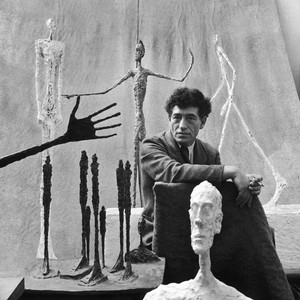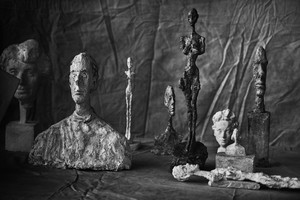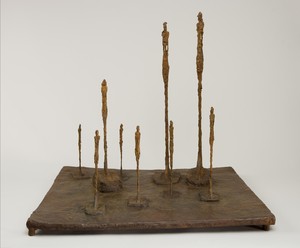
Game Changer
Betty Parsons
Wyatt Allgeier pays homage to the renowned gallerist and artist Betty Parsons (1900–1982).
Art interests me greatly, but truth interests me infinitely more.
—Alberto Giacometti
Alberto Giacometti (1901–1966) devoted much of his career to the struggle between matter and meaning, engaging in an extended exploration of how to reduce the figure’s mass as far as possible while imbuing it with essential force. Jean-Paul Sartre wrote that Giacometti’s depictions of humanity are “always mediating between nothingness and being,” his sculptures evoking the emotional intensity of the void. Often considered testimony to the ravages of postwar Europe, Giacometti’s sculptures, paintings, and drawings possess a timeless quality, inflected with art historical and philosophical narratives, from Surrealism and Expressionism to existentialism and phenomenology.
Born near Stampa, in Switzerland’s southeastern Alps, Giacometti grew up surrounded by the dark shadows, glistening lakes, and precipitous roads of the steep mountain range. This geographic intensity would deeply inform his understanding of mortality and time. In 1922 Giacometti moved to Paris, where, growing dissatisfied with his figurative sculptures, he turned to Cubism, dissecting abstract forms and experimenting with negative space. His search for noncorporeal sculptural forms led to planar, abstract works such as Gazing Head (1928), shown in an exhibition at the Galerie Jeanne Bucher in June 1929. This work caught the attention of the Surrealists, whose thinking would influence the form and content of Giacometti’s work, and expanded the ways he approached themes of destruction, materiality, and the uncanny.
Giacometti often used his close companions as models, from his wife Annette to his brother Diego, as well as poets, writers, and fellow artists including Jean Genet and Eli Lotar, requiring them to sit for many hours—often over several weeks—to capture their likeness to his satisfaction. During these long periods of stillness, he would insist that his sitters offer him a presence as attentive as his own.
In the 1950s, beginning with his second exhibition at the Pierre Matisse Gallery in New York, Giacometti started to gain international acclaim as critics, writers, and philosophers recognized his work as an absolute embodiment of his generation. During this period the artist was particularly focused on representations of the female nude, depicting slender, elegiac forms that emphasize the relationship between the body and gravity. Giacometti produced his famed Femmes de Venise (Women of Venice, 1956) for the French Pavilion of the 1956 Venice Biennale, as well as a concurrent retrospective at the Kunsthalle Bern. Sculpting clay over wire armatures, he created around fifteen figures, nine of which were cast in bronze. Departing from his earlier, impossibly thin “visionary” figures, the Femmes de Venise are rendered with a lifelike accuracy, their somber elegance speaking to universal themes of life and death, darkness and light.
Up until his death in 1966, Giacometti pushed the limits of representation, setting into motion ever-unfolding phenomenological investigations that remain at the core of art making today: How can matter—bronze, plaster, charcoal, paint—embody truth? And how, if at all, can art preserve the essence of the living?


Wyatt Allgeier pays homage to the renowned gallerist and artist Betty Parsons (1900–1982).
Peter Lindbergh discusses photography and the history of his practice with Catherine Grenier, Director of Fondation Giacometti. An accompanying video captures Lindbergh describing the powerful experience he had while photographing sculptures by Alberto Giacometti.

Alberto Giacometti’s iconic sculptures have become the focus of Peter Lindbergh’s photographic gaze. An exhibition at Gagosian London brings together the sculptures and the photographs.

Joachim Pissarro, the curator of Alberto Giacometti Yves Klein: In Search of the Absolute discusses with Gagosian’s Alison McDonald the works and themes that will be presented in this exhibition.
Request more information about
Alberto Giacometti